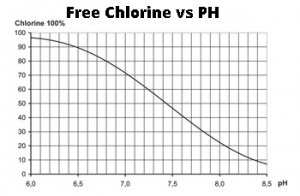We get many inquiries from the pool owners about the chlorine levels in their pool after they install a new chlorinator or replacement cell. It is not uncommon to have different chlorine levels at different water tests. So what determines the chlorine levels in the pool and why can the chlorine levels be different when there is no change in the setup?
Salt levels: It is quite obvious that we need to have a proper salt level for the chlorinator to operate. If you have changed the chlorinator make sure that the salt levels are adjusted to the new unit. Different brands and models of salt chlorinators often work at different salinity levels.
Phosphates: If the phosphate levels are high (together with warm weather and high pool use) the chlorine might be used up by fighting algae at the rate it is produced by the chlorinator. The pool does not have to be green. Phosphates are food that stimulates algae growth. The result is that you can be left with less than the desirable amount of chlorine in your pool. In other words – the algae are killed by produced chlorine but there is not much chlorine left afterward. Recommended phosphate levels in the pool water are below 200 ppb.
Stabiliser: The chlorine gets broken down fast by UV. The way to stop this is to use stabiliser which acts as a sunscreen for the pool water. Recommended stabiliser levels are 30 -50 ppm.
PH: Chlorine is more effective when the PH is low. For obvious reasons, we can not have the pool water lower than neutral, as low PH will be corrosive to equipment and cause skin irritation. The closer we keep PH levels to neutral the better chlorine disinfection we will get. For example, at 7.4 (neutral PH) chlorine is roughly 50% effective and at 8.0 it is only about 20% effective (see chart below). Meaning – the higher the PH the more chlorine is being used in sanitation process and less of it is left in the water.
Testing time: The chlorine readings in your pool water differ depending on the testing time. For example, if you collected the test water in the morning when the chlorinator just stopped working the chlorine reading will be considerably higher than if you take the sample in the afternoon when the pool has been exposed to UV and bathers all day and all the chlorine has already been used before the chlorinator starts working again in the evening.
Test accuracy: If you test chlorine yourself at home make sure that the reagents are not expired and that they have been kept in dry cool place out of sunlight. Expired reagents can cause incorrect chlorine readings.
To determine whether the chlorinator works properly make sure that the salt levels are correct, balance total alkalinity and PH and assure that the phosphate levels are below 200 ppb. Then run the chlorinator overnight at 100% output and take the water sample in the morning. If you still read low or no chlorine levels, then there most likely is a problem with your chlorinator or the electrolytic cell.

